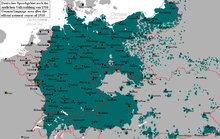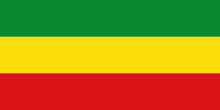Pan movements

The term pan movements , also known as pannationalisms or panideologies , describes a large number of heterogeneous political-cultural movements that have set themselves the goal of increasing the sense of belonging in certain nations or religious communities . Mostly the pan movements strive for the unification of all members of a certain ethnic group , religion or language group . Most of the time, these ethnic or language groups live in many different countries at the time this ideology was created. The Greek prefix Pan- stands for All- to underline that the movements want to encompass more than just individual nationalities. They were and are mostly in bitter contrast to one another, especially since they often have overlapping territorial claims. There are also ideological differences: the European pan movements were mostly imperialist , those outside of Europe were mostly anti-imperialist. Often representatives of the respective pan movements postulated the divine origin or a divine mission of the respective ethnic groups.
history
Modern pan movements played no role in the multipolar world before the late nineteenth century, but the first inclusive ideas can already be found in the Croatian Juraj Križanić , a writer of the seventeenth century. From 1880 to 1945 a variety of macro-nationalist ideologies emerged based on ethnicity (e.g. Pan-Germanism), religion (e.g. Pan-Islamism ), territory (e.g. Pan-Africanism ) or language (e.g. Pan-Anglinism), their character was often imperialistic (e.g. pan- Russianism ), if not downright irredentistic (e.g. panitalianism ). Most of these ideologies lost their significance, however, with the establishment of numerous nation states after the First World War and as a result of decolonization .
In the 19th century, especially the ethnogeografischen ideologies played Pangermanism (including the Panteutonismus) and the Panslawismus (including the Panrussismus) significant roles as political concepts in Europe. Yugoslavia and Czechoslovakia can be seen as manifest examples of the establishment of a pannationalist state. Panitalianism had previously been perfected through the establishment of an Italian nation-state. Other concepts such as Pan-Latinism (including Pan-Romanceism) found little ways to achieve their goals.
From the end of the 19th century the pan movements developed in two opposing directions: Pan-Germanism and Pan-Slavism took on anti-modern, illiberal features. Other forms such as pan-Islamism or pan-Arabism (including pan- Syrism ) saw themselves in an anti-colonial nationalism tradition.
The most recent, because territorially the most extensive forms of pan ideas are the continental geographic ideas of Pan-Asianism , Pan- Eurasism , Pan-Europeanism and Pan-Africanism. But these ideologies also contradict each other: Pan-Africanism was an alternative to European colonial rule over the African continent, Pan-Asianism was a means of promoting Japanese supremacy, and National Socialist Pan-Europeanism saw the Europeans as "civilized peoples" as superior to the other, "barbaric" peoples on.
As a contrast to the pan- Europeanism propagated by the National Socialists, the Pan-European Union is to be seen, which emerged after the horrors of the First World War and can be seen as the advance towards the European Union .
The Pan-Americanism , which does not fit any of the above-mentioned schemes, had its peak during the late 19th and early 20th centuries. Originally it was close to Panhispanism , but developed into a hemispherical concept towards the end of the 19th century. Ultimately, he turned away from his originally linguistic features and turned to geographic and cultural aspects. The United States saw it as the completion of its Manifest Destiny, and many Latin Americans saw it as undisguised US imperialism.
Also to be mentioned as significant ideologies of the Pan group are Greek Panhellenism , Pan- Turkism or Turanism , Scandinavianism , Pan- Serbism (also in the form of "Serbo-Croatism") and Paniberism (also in the form of Panlusitanism ).
Far less unknown or less significant are Pan-Anglicanism , represented by the Pan-Anglican Congress, or Pan-Anglinism as a unit of all English-speaking peoples.
nationalism
Hannah Arendt described the pan movements - especially Pan- Germanism and Pan-Slavism - as particularly aggressive forms of völkisch nationalism . But in many cases the relationship between pan movements and nationalisms is divided.
Other forms
- Pan-Bulgarism
- Paniranism (highlands of Iran, Afghanistan, Tajikistan, Uzbekistan)
- Pan-Catalanism
- Pankelticism
- Pan-Mesopotamism (including Assyrism ; Mesopotamia, Syria, Iraq, Syrian Christians)
- Pan-Mongolism
- Pan-Semitism (Jews and / or Arabs)
- Neo-Slavism
- Pansomalism (Somalia including Ogaden, Djibouti, Northwest Kenya)
- Panindianismus : The Swiss historian Aram Mattioli described in 2014 in the time article published a Panindianismus the troops of Shawnee -Führers Tecumseh .
Pan flags
The following articles describe cross-national flags or colors from which most of the national flags of the region are derived.
literature
- Hannah Arendt : Elements and origins of total domination . Munich 1986, ISBN 3-492-11032-0 . (First published in 1951)
- Tilman Lüdke: Pan ideologies , in: European history online , ed. from the Institute for European History (Mainz) , 2012 Accessed on: December 17, 2012.
Web links
Individual evidence
- ^ A b c d Tilman Lüdke: Pan ideologies. In: European History Online. August 30, 2012, accessed October 1, 2014 (German).
- ↑ a b c d Tilman Lüdke: The history of pan ideologies. In: Pan-Ideologies. European History Online, August 30, 2012, accessed October 10, 2014 (German).
- ^ Hannah Arendt: The origins of totalitarianism. 2nd Edition. 1958, pp. 222-266.
- ↑ Tilam Lüdke: nationalism. In: Pan-Ideologies. European History Online, August 30, 2012, accessed October 10, 2014 (German).
- ↑ Aram Mattioli : >> We shot them like dogs <<, in: The time of December 11, 2014
